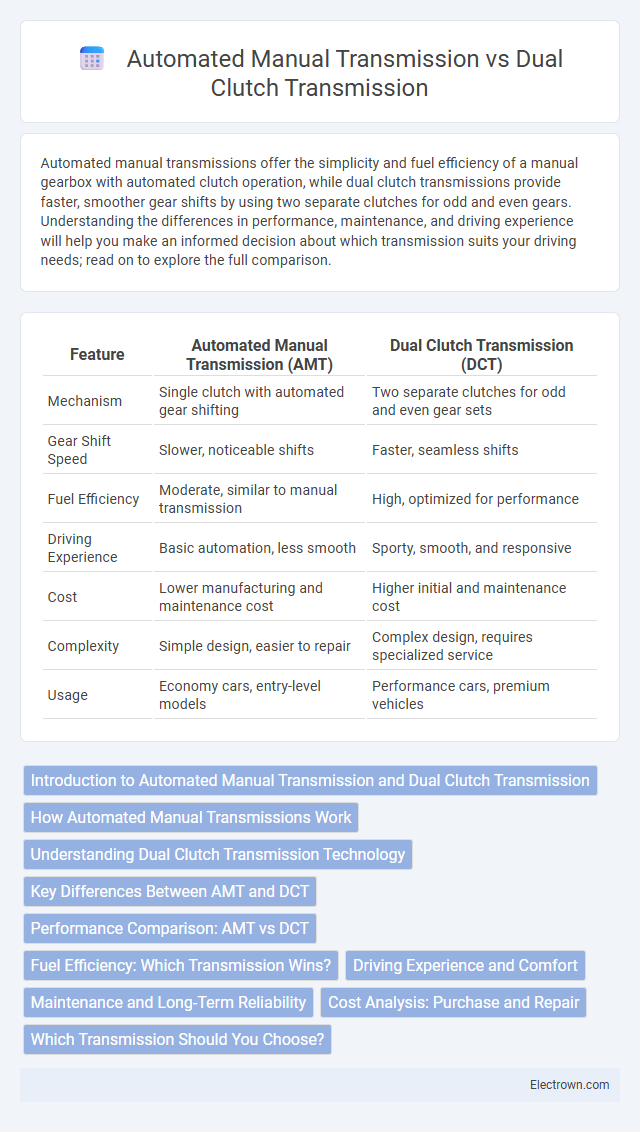Automated manual transmissions offer the simplicity and fuel efficiency of a manual gearbox with automated clutch operation, while dual clutch transmissions provide faster, smoother gear shifts by using two separate clutches for odd and even gears. Understanding the differences in performance, maintenance, and driving experience will help you make an informed decision about which transmission suits your driving needs; read on to explore the full comparison.
Table of Comparison
| Feature | Automated Manual Transmission (AMT) | Dual Clutch Transmission (DCT) |
|---|---|---|
| Mechanism | Single clutch with automated gear shifting | Two separate clutches for odd and even gear sets |
| Gear Shift Speed | Slower, noticeable shifts | Faster, seamless shifts |
| Fuel Efficiency | Moderate, similar to manual transmission | High, optimized for performance |
| Driving Experience | Basic automation, less smooth | Sporty, smooth, and responsive |
| Cost | Lower manufacturing and maintenance cost | Higher initial and maintenance cost |
| Complexity | Simple design, easier to repair | Complex design, requires specialized service |
| Usage | Economy cars, entry-level models | Performance cars, premium vehicles |
Introduction to Automated Manual Transmission and Dual Clutch Transmission
Automated Manual Transmission (AMT) combines a traditional manual gearbox with electronic controls to automate clutch operation and gear shifting, offering improved fuel efficiency and lower maintenance costs compared to conventional automatics. Dual Clutch Transmission (DCT) uses two separate clutches for odd and even gear sets, enabling rapid, seamless shifts that enhance performance and driving dynamics. Understanding the key differences in mechanisms helps you choose the transmission system that best suits your driving preferences and vehicle requirements.
How Automated Manual Transmissions Work
Automated Manual Transmissions (AMTs) operate by combining a traditional manual gearbox with actuators that control clutch engagement and gear shifts electronically, eliminating the need for a clutch pedal. Sensors monitor engine speed and load, allowing precise timing for gear changes to optimize performance and fuel efficiency. This system offers the simplicity and cost-effectiveness of a manual transmission with automated convenience, making it suitable for drivers seeking a balance between control and ease of use.
Understanding Dual Clutch Transmission Technology
Dual Clutch Transmission (DCT) technology employs two separate clutches for odd and even gear sets, enabling rapid and seamless gear shifts that enhance driving performance and fuel efficiency. Unlike Automated Manual Transmission (AMT), which automates clutch operation but retains a single clutch mechanism, DCT offers smoother acceleration and reduced lag by pre-selecting the next gear. Understanding this technology helps you appreciate how DCT combines manual transmission control with automatic convenience for a better driving experience.
Key Differences Between AMT and DCT
Automated Manual Transmission (AMT) uses a traditional manual gearbox with an automated clutch and gear shift mechanism, providing cost-effective fuel efficiency and simpler mechanical design. Dual Clutch Transmission (DCT) employs two separate clutches for odd and even gear sets, delivering faster gear changes and smoother acceleration with superior driving performance. AMT often experiences slight lag during gear shifts, whereas DCT offers near-seamless transitions, making it preferable for high-performance and sporty vehicles.
Performance Comparison: AMT vs DCT
Automated Manual Transmission (AMT) offers smooth gear shifts with lower manufacturing costs but exhibits slower response times and occasional jerks compared to Dual Clutch Transmission (DCT), which provides rapid, seamless gear changes for superior acceleration. DCT's dual-clutch design enables continuous power delivery during shifts, enhancing overall driving performance and fuel efficiency, making it ideal for sporty and performance-oriented vehicles. Your choice between AMT and DCT will depend on whether you prioritize cost-effectiveness and simplicity or advanced performance and responsiveness.
Fuel Efficiency: Which Transmission Wins?
Automated manual transmissions (AMTs) generally offer better fuel efficiency compared to dual-clutch transmissions (DCTs) due to their simpler mechanical design and reduced hydraulic losses. AMTs achieve smoother gear shifts with minimal fuel consumption by optimizing clutch engagement and gear timing through electronic control units. While DCTs provide quicker shifts and performance benefits, their complex dual-clutch system can lead to slightly higher fuel consumption under certain driving conditions.
Driving Experience and Comfort
Automated manual transmissions (AMTs) offer a driving experience close to traditional manuals, providing a more engaging feel but often with slower and less smooth gear shifts that may affect comfort. Dual clutch transmissions (DCTs) deliver rapid, seamless gear changes that enhance acceleration and offer superior driving comfort, ideal for both city and performance driving. DCTs' ability to pre-select gears results in minimal power loss and smoother transitions, making them preferable for drivers seeking a blend of sportiness and convenience.
Maintenance and Long-Term Reliability
Automated manual transmissions (AMTs) generally require less complex maintenance than dual clutch transmissions (DCTs) due to their simpler mechanical design, resulting in lower long-term service costs. Dual clutch transmissions involve more intricate components such as two separate clutches and sophisticated control units, which may lead to higher repair expenses and maintenance frequency over time. Both systems benefit from regular fluid changes and software updates, but DCTs may experience clutch wear sooner under heavy use, impacting their long-term reliability compared to AMTs.
Cost Analysis: Purchase and Repair
Automated manual transmissions (AMTs) generally have a lower initial purchase cost compared to dual-clutch transmissions (DCTs) due to simpler mechanical components and less complex electronics. Repair and maintenance expenses for AMTs are typically more affordable, as their clutches and actuators are easier to service or replace than the intricate dual-clutch systems found in DCTs. However, DCTs may incur higher repair costs over time because of advanced hardware, requiring specialized tools and expertise, which can significantly increase labor charges.
Which Transmission Should You Choose?
Automated manual transmissions (AMTs) offer a cost-effective solution with simpler mechanics and lower maintenance compared to dual clutch transmissions (DCTs), making them ideal for budget-conscious drivers. Dual clutch transmissions provide faster gear shifts, smoother acceleration, and enhanced performance, which suits driving enthusiasts seeking a sportier experience. Your choice depends on whether you prioritize affordability and ease of repair (AMT) or superior driving dynamics and responsiveness (DCT).
Automated manual transmission vs Dual clutch transmission Infographic

 electrown.com
electrown.com